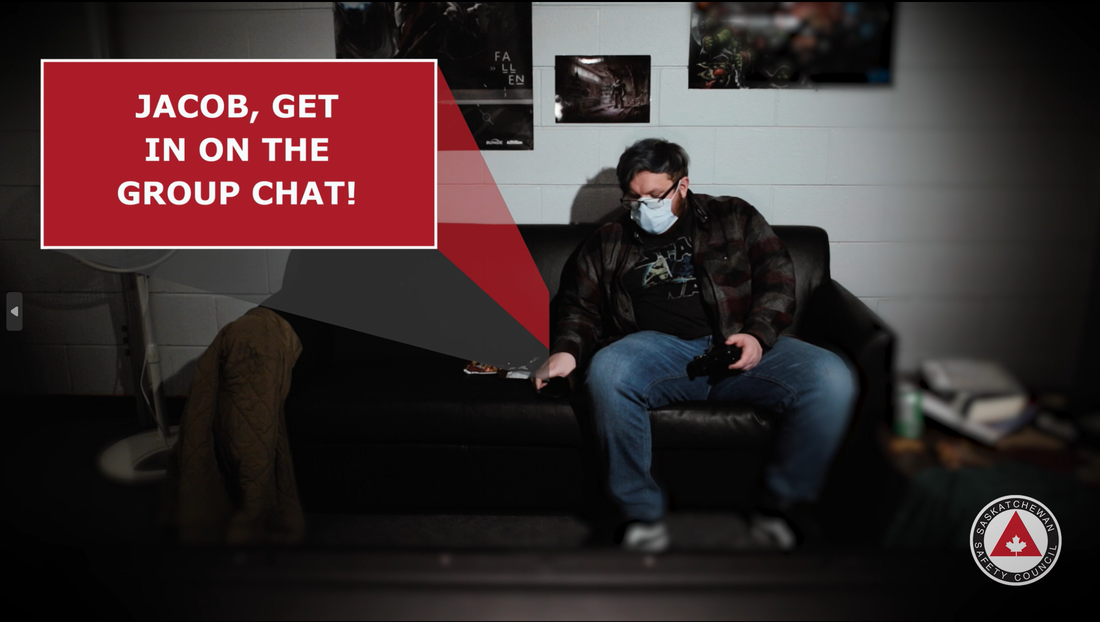|
50 years. Half a century. In an old fashioned place like Saskatchewan, half a century can mean the difference between riding into town on a school bus... Or horseback. Things were different back then… Much different. For those who lived and worked here, the world around them was rife with hazardous environments. With a stubbornly deficient focus on injury prevention, and little awareness or action on the part of leadership, the world was a dangerous place. Injury statistics were not getting better. They were getting worse. For example, seatbelts were not yet mandatory on Saskatchewan roads. Dangerous industries like mining, agriculture, and construction claimed many, many lives each year; with serious injuries occurring at a much greater frequency. Most significant of all, major employers and large companies in the province were doing little to give back to these communities that they served. The province needed a breakthrough. Saskatchewan needed its industry leaders to stand up and make a difference. In 1974, led by the Saskatchewan Safety Council, a collection of prominent Saskatchewan professionals hailing from multiple backgrounds and disciplines first came together in the name of injury prevention. No law or mandate required them to consolidate, and they were not coerced nor commanded to assemble by their employers. Under a banner reading “Let’s Unite for Safety”, these respected leaders gathered by choice, to embark together on a mission to reduce injuries, save lives, and most importantly, enrich the province and community in which they work, live, and raise their families. Now, the enduring legacy of that very first gathering has culminated in this – The Saskatchewan Safety Seminar, the beating heart of injury prevention in Saskatchewan. A momentous three-day seminar, a paramount gathering of professionals, featuring a thrilling combination of face-to-face networking, professional development, and decision-making opportunities. A 50-year long commitment to one’s self and environment reverberates through the hundreds of professionals who right here, right now, in 2023, make the same choice - that they are better than due diligence, that their best practice lies far beyond the minimum requirement, and most importantly, that the connection between their life’s work and the community that they build, protect, and thrive in, is a responsibility that must be shared by all those who broker influence in Saskatchewan. Live and in-person for the first time since 2020, the 50th Saskatchewan Safety Seminar welcomed some of the world's best in injury prevention. Featuring the most esteemed professionals in safety, and hosting delegates representing nearly every industry in the province, the 50th Seminar left attendees with an inspiring, contagious energy. Every attendee was rewarded with the tools and inspiration to return back to their homes, eager to share the favourite lessons, reducing injuries and promoting healthy lifestyles in their workplace, community, and world around them. The 50th Saskatchewan Safety Seminar was everything we missed about live events. Over 700 delegates attended 3 days of action, with 70 tradeshow booths thrilled to interact and showcase, 22 breakout sessions jam packed with practical delivered wisdom, and of course, 4 incredible keynote speakers, capturing the imagination of the room in the palm of their hand. The buzz and anticipation of a full auditorium, the centuries-old chaos of a packed tradeshow market, and the rich, academic aura of expert-led breakout sessions once again returned to Saskatoon, SK, and not a moment too soon. Seminar is back, and it’s bigger and better than ever. This cascading buzz from the 50th Saskatchewan Safety Seminar keeps on rolling into spring, throughout summer, and onwards into next winter. Where, once again, we will gather, share, learn, and unite for safety.
Sponsors of the 50th Saskatchewan Safety Seminar: Armour Safety Bunge North America CANSAFE City of Regina Consumers Co-operative Refineries Crescent Point Energy Corp. DLS Safety Services Evraz North America FWS Group of Companies K+S Potash Canada Kelly Panteluk Construction MLT Aikins Mosaic Company One Stop Services Orano Canada PCL Construction Management PTI Transformers Inc. Saskatchewan Research Council SaskPower Sasktel SGI University of Fredericton Westmoreland Mining Worksafe Saskatchewan Where will you be in 2024? The time is now to explore the 51st Saskatchewan Safety Seminar: https://www.sasksafety.org/saskatchewan-safety-seminar.html Feel the energy of an in-person Safety Event. Explore our professional development days, featuring some of seminar’s most popular speakers: https://www.sasksafety.org/professional_development_days.html Glad to have supported community injury prevention in Saskatchewan? Consider becoming a Member or Sponsor of the Saskatchewan Safety Council: https://www.sasksafety.org/support-us.html Free training and resources are made available thanks to contributions from our Donors, Members and Sponsors that believe in our shared goal of creating a province of safety excellence. Donate today at: www.sasksafety.org/donate - charitable registration number: 11914-0382-RR "C’mon, we’re all doing it!" Have you heard this line before? Peer pressure, social tensions, and violence among youth is not new. Only the popular technology used to influence behviour has changed, and once again, young people have mastered it. In this ever-evolving electronic world, as technology and social development meet, young people always seem to be one step ahead of those that try to intervene early in violent behaviours; often educators, parents, and mentors. Youth have always mastered the trendy and avant-garde technologies of their times. Leading their development, testing the capabilities in ever more creative and involving ways. This often facilitates beautiful expressions of one’s self and environment that can be incredibly healthy and fulfilling. But, for all things there must be balance. Converse to the positive expression, technology can also facilitate the expression of harmful, violent, and even criminal behaviour. The world of cyberbullying - intimidation, humiliation, spamming, harassment, and other harmful tech-facilitated violent behaviours. The trouble for concerned caregivers is that these tech-facilitated communications cannot be seen, heard, or touched. And what’s more, is that the ever-changing evolution of these communication technologies will inhibit a caregiver’s ongoing ability to recognize, intervene, and ultimately treat the youth affected. We decided to investigate this ongoing issue with our friends at Campus Regina Public in Regina, SK. Working with grade 11 students in the “Advanced Media Production & Content Creation Program”, first we discussed issues that were affecting their mental health and social wellbeing. Then, we invited this class to participate hands-on in the production of a short video project on a relevant topic to their daily lives - cyberbullying. What we heard from this class, and what has been documented in surveys collected from hundreds of youth in Saskatchewan, is that the majority of communication happens online, and that cyberbullying had risen to become the most prominent form of bullying. - SAYCW "Youth Health Survey Report 2016" By the mid 2010’s, a technological shift in communication had already occurred long before the youth of today’s school years began. These youth have always felt pressure to join in these new, ever evolving online worlds of communication, a prominent example of which being “group chats”. These multi-user chat spaces are created for seemingly every social circle. Some chats are with family, some are just for friends. Some chats are for sports and rec groups, video games, events, parties… You name it, there is a group chat for it. Two years of online learning supported group chats between classmates and coworkers, teachers and students, further driving much of social behaviour to be expressed online, and further creating an implied approval from authority that online communication is appropriate in most circumstances. The relation between social media, and to an extent communication platforms, is only now starting to become linked to depression, anxiety, and other social stressors. Suicide rates have been steadily rising among youth in Saskatchewan, with suicidal plans and thoughts also being reported by higher and higher percentages of youth (SAYCW study). Behaviours like targeted harassment, privacy violations, social exclusion, and other harmful actions have migrated to the online space with ease. Youth take advantage of the idea that parents, teachers, mentors, and other caregivers are unaware of the harmful communications taking place online. - SAYCW "Thriving Youth, Thriving Communities 2019" Report
As mental health becomes a validated subject as we as caregivers do our best to prevent injuries and promote life, an acute awareness of the modern issues effecting youth is a must in a caregiver's quest to prepare youth with the tools they need to achieve their best. New electronic venues of communication, like “group chats”, are part of a digital world that youth have been forced to learn all on their own. By connecting these modern communication trends facing youth today, to the lessons we have learned from bullying and harassment in the past, we can better care for students and youth to ensure they are prepared to deal with the psychological pitfalls of these modern challenges. Looking for resources? FREE Mental Health Wellness Resiliency Training: https://www.sasksafety.org/online.html Sasktel Be Kind Online: https://bekindonline.com/ Saskatchewan Advocate for Children & Youth: https://www.saskadvocate.ca/ Want to support content just like this? Play a role in the creation of a province of safety excellence. Donate Today at: https://www.sasksafety.org/support-us.html - Charitable Registration Number: 11914-0382-RR Free training and resources are made available thanks to contributions from our Donors, Members and Sponsors that believe in our shared goal of creating a province of safety excellence. |
Archives
November 2023
Categories
All
|










 RSS Feed
RSS Feed
